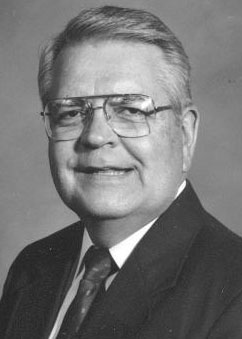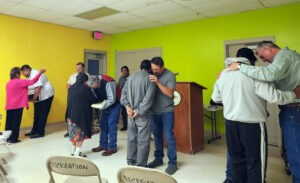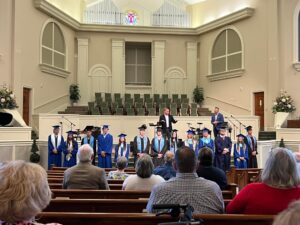
DALLAS (BP)–“Is there anything Christian about Christian Education?” will be the question posed on Dec. 6 during a session of this year’s Southern Association of Colleges and Schools meeting in Atlanta. Academicians from Wheaton, Criswell College, University of Mobile and University of North Texas make up the panel that will address the subject of the integration of faith and learning.
In a paper distributed to panelists prior to the SACS meeting, Wheaton College President Duane Litfin addresses the degree to which academic pursuits at Christian colleges are influenced by their founding religious group. “To an outsider, all church-related institutions may seem alike,” Litfin writes. “But they are not. Whatever their origins, many formerly religious schools are just that, formerly religious,” he said, noting that their religiosity is merely historical or nominal.
According to the U.S. Department of Education, approximately 1,600 of the nearly 4,000 degree-granting institutions of higher education are private schools. About 900 of those are self-defined as religiously affiliated; just under half are from mainline denominations while about a third are Roman Catholic. Evangelical schools make up the remainder at just over 100. Within the Association of Southern Baptist Colleges and Schools are 49 colleges and universities and two Bible schools.
Setting the “formerly religious” schools aside, Litfin focuses on Christian colleges and universities where the religion of the founding group continues to have some direct influence on the institution itself. In a paper that was adapted from his recently published book, “Conceiving the Christian College” (Eerdmanns), the Wheaton president believes it is important to distinguish between two models that represent very different approaches to education.
Litfin’s “Umbrella Model” identifies institutions that “seek to provide a Christian umbrella or canopy under which a variety of voices can thrive,” with Notre Dame and Valparaiso named as examples. The sponsoring faith has privileged status and yet genuine diversity exists through campus voices that “may be unhesitatingly secular, others open but searching while still others may represent competing religious perspectives.”
“All are welcome under the umbrella so long as they can at least support the broad educational mission of the school,” Litfin noted. It may be that the founding group is recognizable in the school’s architecture, traditions, curriculum and activities as well as the governing board, faculty and student body. Key positions such as trustees, top administrators and deans typically are held by those committed to the original faith tradition.
However, the Umbrella Model “seeks to house a variety of perspectives without sacrificing its sponsoring perspective,” Litfin wrote. Such institutions provide an environment “congenial to Christian thinking, but without expecting it of everyone.”
In contrast, the “Systemic Model” seeks to “engage any and all ideas from every perspective, but they attempt to do so from a particular intellectual location, that of the sponsoring Christian tradition,” Litfin wrote. As a result, the faculty will be drawn exclusively from those who embody the founding faith. Within the Council for Christian Colleges and Universities are 105 member schools, all of which likely fall in the category of the Systemic Model since membership is limited to “intentionally Christ-centered institutions.”
Litfin explained the distinction between these two models and a purely secular institution where Christian ideas are often quarantined to the realm of the personal. “Christian truth may be refuted in the classrooms of such institutions but not propounded.” In an Umbrella Model school, such ideas are allowed and even encouraged. Schools designed according to the Systemic Model consider Christian ideas their reason for existence with Wheaton and Calvin College offered as examples.
The Wheaton president cited former Calvin College President Anthony Diekema’s description of a “truly Christian college” as one that “‘articulates a Christian worldview, implemented throughout the curriculum by a faculty whose scholarship is anchored in that perspective.’”
Convening the upcoming panel discussion will be James W. Bryant of Criswell College.
In the realm of Southern Baptist colleges and universities, Bryant senses a renewed interest in moving from an Umbrella Model to a Systemic Model, citing North Greenville College as one school that has successfully made the move.
“Almost all Baptist colleges followed the Umbrella Model by design from the beginning, getting Baptists in the religion department, but anyone in the other disciplines,” said Bryant, pastoral ministry senior professor at Criswell College. He pointed to the University of Mobile and Baylor University as examples of schools that are refocused on integrating faith and learning in the various disciplines.
Criswell College has remained in the camp of the Systemic Model since its founding by W.A. Criswell. With Bryant at the helm when the school was founded in 1971, the school’s name expressed the determination of the founders to build the school solidly on the Bible-centered evangelical theology and evangelistic passion, which characterized the lifelong ministry of Criswell.
“The overriding reason The Criswell College has remained solid is its Articles of Faith,” Bryant stated, referring to the use of the Baptist Faith & Message, along with four amendments that offer greater clarification. Through the school’s affiliation with Southern Baptists of Texas Convention, the intentional inclusion of pastors on the governing board, TCC remains true to Criswell’s vision, Bryant said. He also noted that the continuity of some of the original board members preserves their concern for theological integrity.
It might appear to conservative evangelicals that the Systemic Model is preferable, but Litfin finds both types to be legitimate expressions of an institution’s mission. When failing to understand the model that a school follows, donors, students and even faculty might have expectations that are more realistically applied to the other type.
“A faculty member who teaches in an Umbrella school would perhaps prefer the more focused environment of a Systemic institution,” Litfin wrote. “But instead of moving there she settles for undermining her own school by complaining to all who will listen about the decline of its Christian identity.” Conversely, he noted, a professor at a Systemic school might undermine it “by pining publicly for the idealized features of the Umbrella Model.”
The manner in which academic freedom is applied brings out the critics of schools in the Systemic Model where faculty members are expected to embody the sponsoring faith tradition. However, the American Association of University Professors/AAC Statement on Academic Freedom includes a “limitations clause” giving schools the freedom to adopt their own principles of academic freedom as long as such conditions for hiring are clearly stated in writing in advance.
“The teacher in the evangelical institution operates within the framework of belief confessed by his college,” Arthur Holmes explains in his book, “The Idea of a Christian College.” “In this sense the academic community is always a community of the committed,” Holmes wrote. Such a teacher “is constantly impressed with the fact that the Scriptures aid rather than hinder the quest for truth,” he added. Theological commitments are described by Holmes as “essential in defining the faith and making it a base from which to work at the integration of learning.”
Talk of eliminating the AAUP statement’s “limitations clause” would have little impact on Umbrella institutions, Litfin wrote, but could delegitimize Systemic schools, leaving them isolated. Advocates for one particular model have no business making points at the expense of its counterpart, he argued. “The two types of institutions should see themselves as complementary and work to support one another.”
–30–

















